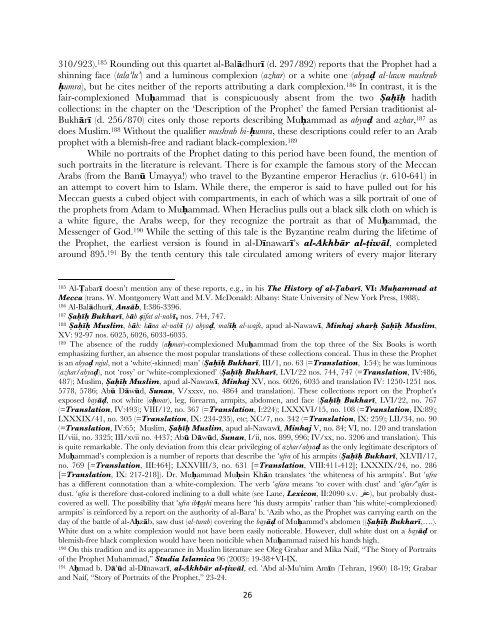Muhammad_Article.349.. - Dr. Wesley Muhammad
Muhammad_Article.349.. - Dr. Wesley Muhammad
Muhammad_Article.349.. - Dr. Wesley Muhammad
You also want an ePaper? Increase the reach of your titles
YUMPU automatically turns print PDFs into web optimized ePapers that Google loves.
310/923). 185 Rounding out this quartet al-Bal§dhurÊ (d. 297/892) reports that the Prophet had a<br />
shinning face (tala"lu") and a luminous complexion (azhar) or a white one (abya∙ al-lawn mushrab<br />
Èumra), but he cites neither of the reports attributing a dark complexion. 186 In contrast, it is the<br />
fair-complexioned MuÈammad that is conspicuously absent from the two ‘aÈÊÈ hadith<br />
collections: in the chapter on the ‘Description of the Prophet’ the famed Persian traditionist al-<br />
Bukh§rÊ (d. 256/870) cites only those reports describing MuÈammad as abya∙ and azhar, 187 as<br />
does Muslim. 188 Without the qualifier mushrab bi-Èumra, these descriptions could refer to an Arab<br />
prophet with a blemish-free and radiant black-complexion. 189<br />
While no portraits of the Prophet dating to this period have been found, the mention of<br />
such portraits in the literature is relevant. There is for example the famous story of the Meccan<br />
Arabs (from the Banå Umayya!) who travel to the Byzantine emperor Heraclius (r. 610-641) in<br />
an attempt to covert him to Islam. While there, the emperor is said to have pulled out for his<br />
Meccan guests a cubed object with compartments, in each of which was a silk portrait of one of<br />
the prophets from Adam to MuÈammad. When Heraclius pulls out a black silk cloth on which is<br />
a white figure, the Arabs weep, for they recognize the portrait as that of MuÈammad, the<br />
Messenger of God. 190 While the setting of this tale is the Byzantine realm during the lifetime of<br />
the Prophet, the earliest version is found in al-DÊnawarÊ’s al-Akhb§r al-ãiw§l, completed<br />
around 895. 191 By the tenth century this tale circulated among writers of every major literary<br />
185 Al-•abarÊ doesn’t mention any of these reports, e.g., in his The History of al-•abarÊ, VI: MuÈammad at<br />
Mecca (trans. W. Montgomery Watt and M.V. McDonald: Albany: State University of New York Press, 1988).<br />
186 Al-Bal§dhurÊ, Ans§b, I:386-3396.<br />
187 ‘aÈÊÈ BukharÊ, b§b ßifat al-nabÊ, nos. 744, 747.<br />
188 ‘aÈÊÈ Muslim, b§b: k§na al-nabÊ (s) abya∙, malÊÈ al-wajh, apud al-NawawÊ, Minhaj sharÈ ‘aÈÊÈ Muslim,<br />
XV: 92-97 nos. 6025, 6026, 6033-6035.<br />
189 The absence of the ruddy (aÈmar)-complexioned MuÈammad from the top three of the Six Books is worth<br />
emphasizing further, an absence the most popular translations of these collections conceal. Thus in these the Prophet<br />
is an abya∙ rajul, not a ‘white(-skinned) man’ (‘aÈÊÈ BukharÊ, III/1, no. 63 (=Translation, I:54); he was luminous<br />
(azhar/abya∙), not ‘rosy’ or ‘white-complexioned’ (‘aÈÊÈ BukharÊ, LVI/22 nos. 744, 747 (=Translation, IV:486,<br />
487); Muslim, ‘aÈÊÈ Muslim, apud al-NawawÊ, Minhaj XV, nos. 6026, 6035 and translation IV: 1250-1251 nos.<br />
5778, 5786; Abå D§wåd, Sunan, V/xxxv, no. 4864 and translation). These collections report on the Prophet’s<br />
exposed bay§∙, not white (aÈmar), leg, forearm, armpits, abdomen, and face (‘aÈÊÈ BukharÊ, LVI/22, no. 767<br />
(=Translation, IV:493); VIII/12, no. 367 (=Translation, I:224); LXXXVI/15, no. 108 (=Translation, IX:89);<br />
LXXXIX/41, no. 305 (=Translation, IX: 234-235), etc; XC/7, no. 342 (=Translation, IX: 259); LII/34, no. 90<br />
(=Translation, IV:65; Muslim, ‘aÈÊÈ Muslim, apud al-NawawÊ, Minhaj V, no. 84; VI, no. 120 and translation<br />
II/viii, no. 3325; III/xvii no. 4437; Abå D§wåd, Sunan, I/ii, nos. 899, 996; IV/xx, no. 3206 and translation). This<br />
is quite remarkable. The only deviation from this clear privileging of azhar/abya∙ as the only legitimate descriptors of<br />
MuÈammad’s complexion is a number of reports that describe the #ufra of his armpits (‘aÈÊÈ BukharÊ, XLVII/17,<br />
no. 769 [=Translation, III:464]; LXXVIII/3, no. 631 [=Translation, VIII:411-412]; LXXXIX/24, no. 286<br />
[=Translation, IX: 217-218]). <strong>Dr</strong>. MuÈammad MuÈsin Kh§n translates ‘the whiteness of his armpits’. But #ufra<br />
has a different connotation than a white-complexion. The verb #afara means ‘to cover with dust’ and #afar/#ufar is<br />
dust. #ufra is therefore dust-colored inclining to a dull white (see Lane, Lexicon, II:2090 s.v. رفع), but probably dustcovered<br />
as well. The possibility that #ufra ibãayhi means here ‘his dusty armpits’ rather than ‘his white(-complexioned)<br />
armpits’ is reinforced by a report on the authority of al-Bara’ b. ‘Azib who, as the Prophet was carrying earth on the<br />
day of the battle of al-AÈz§b, saw dust (al-turab) covering the bay§∙ of MuÈammd’s abdomen ((‘aÈÊÈ BukharÊ,….).<br />
White dust on a white complexion would not have been easily noticeable. However, dull white dust on a bay§∙ or<br />
blemish-free black complexion would have been noticible when MuÈammad raised his hands high.<br />
190 On this tradition and its appearance in Muslim literature see Oleg Grabar and Mika Naif, “The Story of Portraits<br />
of the Prophet <strong>Muhammad</strong>,” Studia Islamica 96 (2003): 19-38+VI-IX.<br />
191 AÈmad b. D§"åd al-DÊnawarÊ, al-Akhb§r al-ãiw§l, ed. #Abd al-Mu"nim AmÊn (Tehran, 1960) 18-19; Grabar<br />
and Naif, “Story of Portraits of the Prophet,” 23-24.<br />
26

















